The space debris was simply ejected from the station — most of it was supposed to burn up in the Earth’s atmosphere, but one of the fragments «survived» and pierced the roof and floor in the two-story house of a Florida resident.
Hello. Looks like one of those pieces missed Ft Myers and landed in my house in Naples.
Tore through the roof and went thru 2 floors. Almost his my son.
Can you please assist with getting NASA to connect with me? I’ve left messages and emails without a response. pic.twitter.com/Yi29f3EwyV— Alejandro Otero (@Alejandro0tero) March 15, 2024
NASA specialists immediately arrived at the scene and took the kilogram object for further investigation. The agency has now confirmed that it is really «arrived» from the ISS and is part of a cargo pallet with old batteries with a total weight of 2630 kg (namely «support beam»), which was dropped from the station in 2021.

The pole itself is made of nickel (a metal alloy that can withstand extreme conditions such as high temperature, pressure, or mechanical stress), weighs about a kilogram, and measures 10 cm in height and 4 cm in diameter (slightly smaller than a standard Red Bull can).
«The equipment was expected to completely burn up during reentry on March 8, 2024,» NASA said. «The ISS will conduct a detailed investigation to determine the cause of the «survival of the» debris and update modeling and analysis as necessary. These models require detailed input parameters and are regularly updated whenever debris is found to have survived re-entry into Earth’s atmosphere.
The history of debris from the ISS is related to by the unsuccessful launch of a Russian spacecraft «alliance» more than 5 years ago, which was forced to make a rapid ballistic descent due to problems with the launch vehicle. On board were Russian Alexander Ovchinin and NASA astronaut Nick Hague, who was supposed to go into space to install a new set of lithium-ion batteries delivered by the Japanese HTV cargo ship to the ISS, but the mission was postponed until 2018.
This delay in the carefully crafted schedule has thrown a wrench into the entire multi-year plan to modernize the batteries of the ISS electrical system. Each time, the HTV ship delivered new batteries to the station and picked up the old ones — the last time it happened in 2020, and since then the last design with faulty batteries has remained on the ISS (other cargo vehicles — SpaceX’s Dragon, Northrop Grumman’s Cygnus, and Russia’s Progress — cannot accommodate the HTV cargo pallet). In March 2021, NASA «ejected the» battery cargo using a robotic arm — it drifted in orbit for three years until aerodynamic drag pushed the structure back into the atmosphere.
